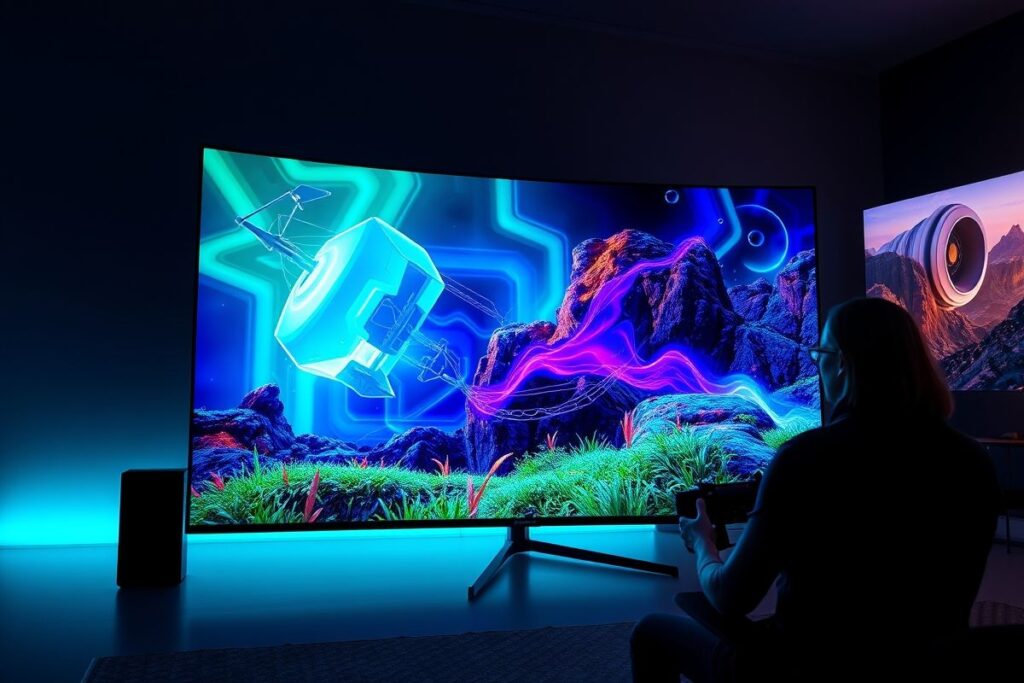OLED Technology Beyond Gaming
OLED (Organic Light Emitting Diode) technology has revolutionized the gaming world with its stunning visuals, vibrant colors, and lightning-fast response times. But the impact of this innovative display technology extends far beyond the realm of entertainment. From revolutionizing televisions and smartphones to transforming the future of virtual reality and wearable technology, OLED is poised to reshape how we interact with the digital world. Its inherent flexibility and potential for transparency open doors to exciting possibilities in diverse fields like automotive displays, lighting, and even medical imaging. This article will delve into the exciting applications of OLED technology beyond gaming, exploring its current impact and future potential.

OLED in Televisions and Smartphones
Transforming the Viewing Experience
OLED technology has significantly enhanced the television viewing experience. Unlike traditional LCD screens that rely on backlights, each OLED pixel emits its own light. This allows for perfect blacks and infinite contrast ratios, resulting in breathtaking picture quality. The absence of a backlight also makes OLED TVs incredibly thin and energy-efficient. They offer wider viewing angles and superior color accuracy, making them the preferred choice for cinephiles and home theater enthusiasts.
Similarly, OLED screens are becoming increasingly prevalent in smartphones. The technology’s ability to produce vibrant colors and deep blacks makes it ideal for displaying high-dynamic-range (HDR) content. The improved power efficiency also contributes to longer battery life, a crucial factor for mobile devices. The flexible nature of OLEDs has further enabled manufacturers to create curved and foldable smartphone displays, pushing the boundaries of design and functionality.
OLED panels are also used for computer monitors, offering a significant leap in image clarity and response times. Photographers and videographers find the enhanced color accuracy and contrast essential for their work.
The Future of Display Technology
OLED is continuously evolving, with advancements like QD-OLED and microLED on the horizon. QD-OLED combines the benefits of OLED with quantum dot technology, resulting in even wider color gamuts and increased brightness. MicroLED, still in its early stages, promises even greater energy efficiency and brightness, potentially surpassing all existing display technologies.
As manufacturing costs decrease and production scales up, OLED technology is expected to become even more accessible and ubiquitous. Its superior performance and unique capabilities position it as the dominant display technology of the future.
The Evolution of OLED
The ongoing development of OLED technology is driven by the increasing demand for higher resolution, better color accuracy, and improved energy efficiency. These advancements are not only enhancing consumer electronics but also impacting other industries.
OLED in Wearable Technology and VR
A Seamless and Immersive Experience
The flexibility and lightweight nature of OLEDs make them perfectly suited for wearable technology. From smartwatches to fitness trackers, OLED displays provide crisp, clear visuals in a compact form factor. Their low power consumption is also crucial for extending the battery life of these devices. Furthermore, the ability to create flexible OLED displays opens up new possibilities for wearable designs, such as curved displays that conform to the wrist or even integrated into clothing.
In the realm of virtual reality (VR) and augmented reality (AR), OLED displays are essential for creating immersive experiences. The high refresh rates and low response times minimize motion blur and latency, crucial for avoiding motion sickness and enhancing realism. The vibrant colors and deep blacks of OLED also contribute to a more believable and engaging virtual environment.
OLED technology is key to making VR and AR headsets smaller, lighter, and more comfortable to wear.
Pushing the Boundaries of Innovation
As OLED technology continues to evolve, its impact on wearable technology and VR will only grow. Flexible and transparent OLEDs could lead to innovative new wearable devices, while advancements in resolution and refresh rates will further enhance the immersiveness of VR and AR experiences.
The potential applications of OLED in these fields are vast, paving the way for a future where digital information is seamlessly integrated into our daily lives.
The Impact of OLED on VR/AR
OLED displays are transforming the VR/AR landscape, enabling more realistic and immersive experiences. The advancements in this technology are driving innovation in both hardware and software development.
OLED in Automotive and Lighting
Illuminating the Future
OLED technology is beginning to make its mark in the automotive industry. Flexible OLED displays can be seamlessly integrated into dashboards and center consoles, creating sleek and futuristic interiors. Transparent OLEDs can even be used for heads-up displays, projecting information directly onto the windshield without obstructing the driver’s view. OLED lighting panels offer unique design possibilities, allowing for customizable ambient lighting and dynamic taillights.
Beyond automotive, OLED technology has the potential to revolutionize lighting. OLED panels can be made into large, thin, and flexible light sources, offering a more energy-efficient and aesthetically pleasing alternative to traditional lighting solutions. Their ability to be molded into different shapes and sizes opens up new possibilities for architectural lighting and interior design.
OLED lighting also offers advantages in terms of color accuracy and control, enabling dynamic lighting scenarios that can adapt to different moods and environments.
Beyond Traditional Lighting
OLED lighting is poised to disrupt the lighting industry with its energy efficiency, design flexibility, and potential for creating dynamic and interactive lighting experiences. From smart homes to public spaces, OLED lighting offers a glimpse into the future of illumination.
As research and development continue, we can expect to see even more innovative applications of OLED technology in lighting and automotive design.
OLED’s Impact on Automotive Design
OLED displays are transforming the automotive industry by enabling new design possibilities and enhancing the driving experience. This technology is at the forefront of creating more intuitive and interactive vehicle interfaces.
| Feature | OLED | LCD |
|---|---|---|
| Black Levels | Perfect Black | Dark Gray |
| Response Time | Instantaneous | Slower |
| Viewing Angle | Wider | Narrower |
- Benefit 1: Superior image quality
- Benefit 2: Enhanced flexibility
- Benefit 3: Improved energy efficiency

Leave a Reply